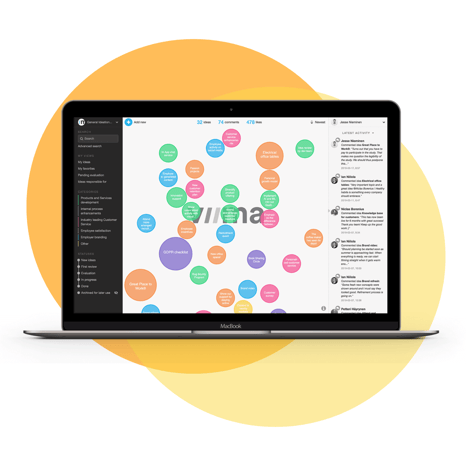Why Isn’t Your Suggestion Box Working?
Oh, the suggestion box. Such a little innocent concept, a simple object. Yet it holds a peculiar power to divide people into two opposing camps. One group will state with vigor that the suggestion box is dead. The other one will claim that the suggestion box is a crucial part of your business’s growth.
So, which one holds true?
Sure, the good old, beaten-up box is obsolete and rarely seen around; however, it does not mean that the concept isn’t working. Quite the contrary. The suggestion box simply changed shape and is currently thriving in the digital world in many different forms: pulse surveys, employee engagement tools, idea collection software, feedback, and so on.
While the name might be different and the looks might have changed, suggestion box is just as useful as it used to be back in the day. And in today’s article, I will cover all the main reasons why you should be using a suggestion box and what is the best approach to make it work.
Table of contents

What is a Suggestion Box?
Suggestion box, no matter under what other aliases it would be disguised, is a tool for idea management.
It can be a permanent fixture in your office, running all year long, enabling people to submit ideas whenever they have one. It can also be used as a short-term campaign tool to garner ideas around a specific issue, project or to reflect on a period of time. The way to use it is not set in stone either.
While some companies use the suggestion box strictly for new idea generation, others might use it for any suggestions, without clear requirements, and a third group might utilize it simply as a feedback tool.
At the end of the day, a suggestion box is exactly what the name hints at – a box (physical or digital) to submit suggestions to.
A Little Bit of History
While various sources imply that the history of the suggestion box started in the 18th century (either in England or Japan), the phenomenon really kicked off in the 1940s in the United States.
During World War II, the US government pushed relentlessly to improve productivity and efficiency in manufacturing, and one of the ways to do that was a little tool called a suggestion box. What businesses came to realize back then was the old and often forgotten truth – frontline employees are a gold mine for innovative ideas.
So, to tackle staff and material shortage, businesses asked their workforce, what could be done differently. They were not disappointed by the solutions workers were able to deliver. In return, the federal government promoted the idea of the suggestion box as a workers’ contribution toward victory, making the process somewhat of civic duty.
The following decades saw increased use of the tool for private gains or at least, for major savings. However, with time, “ideas for victory” started to slow down.
Today, chances are that you won’t find one in the average office. And for all the right and understandable reasons.
What Happened to the Good Old Suggestion Box?
Some years back I used to work in a company that still relied on a physical suggestion box.
We had other tools to convey ideas too, but at the end of a calendar year, a big, glossy box would pop up in a conference room. We all dreaded that part of wrapping up the year because we all saw how broken and useless the process was.
First, it was tragically demotivating for those, who were expected to contribute suggestions, because we rarely (if ever) received any feedback or progress updates regarding the suggestions we had left.
Secondly, it must have been a disheartening process for the team leads assigned to handle the slips. As physical boxes do not provide any filter, the team lead would be burdened to sort through pointless and even less-savory slips, and no one wants to handle that sort of work.
There’s always that one person who would use the opportunity to simply vent their frustrations through the process or demand impossible things.
Thus, all the suggestions, be they superb and cost-saving, or just time-wasting jokes would start to pile up, clogging the box which in return would send an obvious message to the most creative individuals – your ideas do not matter.
Suggestions stuck in the backlog of the suggestion box sends a clear message to your employees - their ideas do not matter
Lastly, for us it was a mandatory process, meaning that the number of slips provided would be counted at the end of the cycle, and should there be a lack of any, there would be constant laments from the higher-ups. This sort of entrapment does not generate ideas, it suffocates creativity.
At the end of the day, in that environment, the suggestion box was merely a relic of the ‘60s, the time when the company was originally established. It was an absurd tribute to the old ways of operation with its obscure employee engagement KPIs.
The issues that were persistent and obvious in my personal experience – lack of structure, unclear goals, and no plan of what to do after are the common denominators that break the most of suggestion boxes. Above all, lack of accountability seemed to be the most painful blow to the process.
I will discuss these points in more detail later in the post and I will provide some tips how to avoid or fix them.
Lack of accountability derived from highly encouraged anonymous submission process. The management strongly believed that anonymity was the only way to receive honest opinions from the teams.
However, if the team leader would eventually bring up an idea from the box to discuss further with the team, everyone would just shrug their shoulders without wanting to admit whose idea it was. And, because the original idea is always missing some important details and consideration, this led to a massive amount of untapped potential.

Anonymous vs Identified
Anonymity is not the only approach to a suggestion box. Some companies opt for identified submissions, with people taking full accountability of their ideas, some have option to submit suggestions in either way.
It isn’t exactly a black or white matter. It is up to you and your team to determine, which approach is more fitting, and to make that step a tad bit easier for yourself, consider the following points:
Pros of Anonymity
Even though a particular field or career path attracts like-minded people, at the end of the day, we all are very different.
1. Anonymity helps shy and quiet employees to find their voices. Someone might be bold and willing to express their opinions loudly, and there are those, who feel the best when they can communicate anonymously, thus such option helps these members to stay true to themselves, but also contribute to the company’s growth efforts actively.
2. Anonymity erases biases and discrimination. Unfortunately, workplace biases are still a thing. When it comes to the suggestion box, anonymity is certainly a good option in tackling this issue. It allows the responsible person to look at all the submitted information without any prejudgment and appreciate each input equally.
3. Anonymity eliminates fear. In certain settings, it is difficult to express yourself honestly. There might be cultural habits not allowing us to say anything that would contradict management or fear of losing respect (or even job) should we express an unpopular opinion. Once the option to stay anonymous exists, fears get diminished allowing people to be honest and open.
Anonymity does not eliminate all of the issues arising from fears and it does not guarantee active submissions or quality contributions.
Psychological safety in workplace should come first, it’s crucial and truly worth cultivating.
Cons of Anonymity
An opportunity to stay anonymous brings many benefits, unfortunately, it brings negatives too.
1. Anonymity may diminish boundaries and respect. Anonymity might lead people to use suggestion box as an outlet for such negativity like complains not related to work life, personal disliking of someone etc. This should not be mixed with negative feedback – which is still a great source of learning and improvement. But just plain, negative commentary is unproductive and toxic.
2. Anonymity makes it harder to filter ideas. Accountability, as mentioned earlier, is important for idea implementation. Owning your ideas allows to see them through all of the stages of development. Lack of it makes is hard to filter, prioritize, and develop suggestions, which means that you’re losing out on a lot of potential.
3. Anonymity invites superfluous ideas. Not every suggestion is equally good or valuable. If you have a short-term suggestion box campaign running, chances are, you are looking for solutions in a specific area. The last thing you need is unnecessary spam. 10 bad ideas might simply bury one good suggestion.
What to Choose?
There are several things to be considered in advance that might help to tackle possible issues:
- When possible, offer communication training sessions.
- Set clear goals and explain what is expected of contributors.
- Provide examples of dos and don’ts.
- Discuss negative comments before you kick off the campaign. This is especially important for those, who will be responsible for handling the input.
Lastly, it might help to consider another outlet for feedback, which might cover interpersonal matters, separate from a suggestion box.

Suggestion vs Feedback
Suggestion and feedback are two different things. Nonetheless, these terms and tools to garner both are often used interchangeably. There are several things worth to consider before you decide whether you should mix these two too.
Suggestion is exactly that – an idea, sometimes with a plan, that might be worth considering. Suggestions focus more on processes, products, design, and continuous improvement within the organization, and these are exactly the things we all want while running a suggestion box campaign.
Whereas feedback is information about a reaction to a product, service, or person’s performance. It is usually given with the intent to improve something.
Often, the best, worth implementing ideas aren’t really ideas to begin with. They might derive from a conversation or feedback session – someone simply questioning a step within a process or providing feedback on a product, completely unintentionally pointing out non-obvious but big problem.
At the same time, feedback on person’s performance is crucial for professional and interpersonal growth within the organization. However, if delivered in unstructured, indirect, and especially anonymous manner, it can touch a tad bit personal aspects and might cause discomfort.
Unstructured, indirect and anonymous feedback can touch on personal aspects and cause discomfort
Whenever it’s possible such feedback should be given in feedback sessions or one-to-one type of meetings. A conversation allows body language and facial expressions to contribute to talking, which might soften the feedback.
On the other hand, typed words submitted to the suggestion box can be misinterpreted and often understood as a personal critique.
Naturally, not every organization has a luxury to run one-to-one’s for absolutely each member. Above all, it’s nearly impossible to receive customers’ feedback – pivotal for growth – in any other shape or form than digital (and mostly anonymous). Thus, it makes sense to rely on suggestion box tools to gather and process feedback too.
Consider, whether you should use a different tool than the suggestion box to collect feedback. Either way, discussing these points with your team before you launch a it will save time and unnecessary distress.
Why is the concept still useful?
No matter how well one knows their business or customers, it is impossible to know what’s happening in every unit or on the frontlines. Therefore, the suggestion box can still serve its true purpose in any organization and empower members from different teams to contribute towards improvements in many areas.
As long as the process works like a well-oiled machine, it can:
Inspire Innovation
It still stands true that the suggestion box is a great tool to gather ideas which in return creates a more innovative space. A transparent process and easy to share knowledge breaks barriers between different sectors of a company and inspires innovation across the organization. Management can easily gather different perspectives on one and the same issue.
In addition, employee suggestions might unlock new knowledge about customer needs, that management never knew about.
Detect Problems and Bottlenecks
A sneaky and undetected issue in one department might cause trouble for another one. To save the latter from running in circles, the suggestion box enables a flow of ideas from multiple departments, making it easier to detect earlier unnoticed issues and to troubleshoot them.
Boost Morale
Creating a space where your team member’s opinion matters and where they can contribute to growth in more ways than just their core duties – boosts morale. It is human of us to crave recognition and to want to be heard. A workspace that appreciates everyone’s input creates a positive atmosphere.
Improve Communication
A suggestion box can be a fantastic tool to give voice to the silent members of the team. Not everyone is willing to bring forth ideas that might contradict management. It especially is prevalent in hierarchical organizations. Thus, a suggestion box can be a great tool to stay proactive and expressive without the burden of confrontation or public speaking.
Strengthen the Company Culture
Valuing employees’ opinions shows them that their voices and input matters, that they can make an impact. Utilizing such tools as a suggestion box helps employees to invest their time in company’s growth efforts, because they know that they will be acknowledge for it.

How do you make it work?
There are plenty of good reasons to have a suggestion box set in place. However, as mentioned before, it all depends on how you set it up and what steps you take before the kick-off.
Below is a list of things to consider before your next suggestion box campaign.
1. Clarify Your Goals
Before you launch it, you must consider why does your team/company need a suggestion box? If it’s just a new tool or program you want to try out, it might not stick. Rather, focus on real company goals: how to reduce time spent on X or Y function; how to improve customer experience on your web shop; what will be the next feature of the product etc.
Once you narrow down all the reasons why – invite your team members to provide their suggestions. Specific goals make is much easier for people to contribute and for the responsible members to analyze, file and manage the input.
2. Plan Few Steps Ahead
Build and present a plan to everyone included in the process of what to do after and consider: how often suggestions will be reviewed, who will do that, based on what criteria, and what steps will then be taken to implement the chosen ideas.
3. Bring the Team Together
It is vital to consider responsibilities well in advance. Especially in a case when a suggestion box tool is used by several different teams or departments, intricate knowledge of the field is needed, thus HR might not be the right team to handle the input.
Consider who will review, approve, or reject suggestions and who will be responsible for communication around them. In many organizations, these steps are taken care of by innovation committees. If you are relying on one too, make sure it includes a group of proactive people, capable to align innovation projects with business’s goals.
4. Clarify the Process
Once you know why, who, and what they are doing, it is good to explain it to the rest of your team. Present the earlier steps and how you expect them to be executed to those, whose contribution you expect.
5. Work on Creating Psychological Safety
It will be nearly impossible to encourage people to submit their ideas if your company’s culture is not built on open communication. Trust is essential. If there’s a history of repercussions for those who speak up or a history of initiatives completely disregarded, people will be demotivated to respond to this campaign too.
6. Provide Examples
Examples can encourage people to contribute their ideas. A lot of us get stuck because of the impostor syndrome, lack of confidence, or fear of saying something silly. Providing several different examples of what you expect, what is acceptable, and especially, unlikely ideas that worked in the past will ease people into the process and help them decide whether their ideas are fitting.
7. Set Boundaries
Like in any healthy relationship, boundaries are crucial. Establish clear and concrete areas for suggestions and ask questions instead of giving total freedom to write freestyle. This will reduce the amount of unfitting and time wasting suggestions.
8. Follow up with Contributors
Quite often, the suggestion box process dies down because ideas are getting filed who-knows-where, for who-knows-how-long. It is discouraging to all of us when we spend time on something, that never gets considered or acknowledged. Feedback as to why a suggestion worked, failed, or has been postponed will make people feel like a part of the process, increase morale and also, serve as a way to learn.
9. Give Autonomy
If possible, give the freedom and autonomy for people to own their ideas. You can ask them for solutions to improvements they suggest and whether they want to work on making that happen. Quite often people will bring up things that are important to their duties and they might have a plan on how to fix those issues. Offer guidance and assistance needed for them to work on such projects.
10. Talk About Implemented Suggestions
Whenever an employee’s suggestion gets implemented, be it big, cost cutting, or minor, workflow improving – celebrate it and give credit to the people that came up with and implemented the suggestions.
11. Reward People
Often giving credit is enough, however, sometimes bigger rewards should be considered to motivate and appreciate people’s input and hard work. There are studies showing that cash rewards do not always work as intended, thus when thinking about rewarding implemented suggestions, expand your horizon. Some enjoy company memorabilia, some might prefer a gift coupon, and the third group might appreciate shaking a CEO’s hand or having lunch with them.
The best way to determine what works for your team is to either ask what people expect or you can set a list of options and allow team members to choose.
Remember:
- Do not force idea generation quotas upon your team.
- Consider your team’s unique cultural and personal needs and traits.
- A successful suggestion box relies on good communication.
- Consider the tools. If you are committed to launch the suggestion box, a dedicated tool will cut the hassle and turn the process to rewarding and enjoyable process.
However, if you are still unsure of what to use, perhaps the next section of the post will help you to make up your mind.

Tools to improve the process
The world has changed quite a bit since the 18th century. A physical suggestion box makes it difficult to process, sort, analyze and follow-up on suggestions. Above all, in today’s world when so many work activities can be performed remotely, the box sitting on your office’s windowsill does not serve its purpose.
The time is ripe to kiss it goodbye and get your hands on more practical, versatile, and easy-to-use digital tools. Let’s take a look at some of them.
Use What You Have
Every day at work you use applications, tools, and websites without even considering that they can be used in a different way, for example – as a suggestion box. Such common tools can be divided into three categories: intranet software, communication applications and survey software.
Let’s look at each group and its benefits separately:
1. Intranet: many medium- to large-sized organizations uses some form of intranet to make communication, file storage and sharing easier. For example, SharePoint can be used in such fashion. Often, intranet platforms can be customized and made into your businesses’ own social media.
The great part of these tools is that everyone within your organization is familiar with the interface, making it easy to use and navigate. It usually can be accessed via browser, without a need to install additional applications.
2. Communication Platforms: such communication tools as Slack, Microsoft Teams, even WhatsApp or Signal can serve as a suggestion box for a short-term campaign. Just like with intranet, your team already knows how to use it. It is a perfect solution for those, who need to receive suggestions immediately and especially if they know whom they want to contact directly.
3. Surveys: For example, Google Forms or Microsoft Forms is a great and simple-to-use tool that allows you to create a survey/quiz. It is especially useful if you have a specific issue that needs suggestions on how to solve it. Forms has a feature to accept anonymous or identified submissions, multiple choice, or open-ended questions, and you can export data to an Excel file.
Common drawbacks: While these tools have some advantages and can generate ideas quickly, they also have shortcomings. These are mostly one-way communication tools that simply were not designed for this purpose. Perhaps the biggest drawback is the fact that they cannot be effectively used for large scale or long-term campaigns. In addition, it is nearly impossible to compare and evaluate ideas, to follow up with people and track progress.
Even though direct messaging can provide quick answers and help to collect insights, it is not user-friendly to run systemic, large-scale campaigns nor does it work for creating processes that are needed for long-term outcomes.
Use Something New
If you are serious about making the suggestion box as a part of your team’s everyday life, you might need to expand your horizons and try something completely new. These new tools could be for example employee engagement apps, or – you could fully commit to a dedicated suggestion box software.
1. Employee Engagement Applications: Engagement apps come with various features allowing you to plan and carry out training and learning sessions, manage schedules and chat with different team members. In addition, such tools as Polly, Culture Amp or Leapsome offer a certain level of anonymity, allow people to vote for others’ ideas, contribute their own, and answer questions.
They are convenient for the organizer to use, enabling them to ask questions often and from a lot of people. Finally, these apps offer a much better user experience than the above-mentioned tools, making them quite pleasant and easy to use.
Drawbacks: There are many good reasons to use employee engagement apps and while they can satisfy your basic suggestion box needs, it’s worth considering the limitations too. Just as the first group, these tools are not intended to be used as a long-term suggestion box or idea collection tool. They make it nearly impossible to sort and eliminate duplicate ideas, track their progress, and follow up with contributors.
2. Dedicated Suggestion Box Tools: For those who are looking for a more flexible, all-encompassing solution, idea management (IM) software will do the trick. There are plenty of different IM tools out there (you can check our favorite tools here) that can help you easily connect your whole organization – no matter how big or small – to the suggestion box campaign.
Having one suggestion box for all the teams across a mid-sized or large organization can make things truly messy. IM tools, for example, Viima allows you to create several virtual suggestion boxes at the same time, allowing each department to have their designated location, for their unique needs and problems.
The brilliant thing is, you don't need a seperate tool per team – all these different suggestions boxes can be easily organized, managed and edited within the dedicated IM tool.
In addition, such tools allow you to collect and manage ideas in a transparent and interactive manner – you can talk with contributors, give feedback on the spot and follow-up via the built-in features. Also, the analytics capabilities will help you to understand how well you're doing and what to improve upon.
Drawbacks: While a dedicated tool fills in all the gaps left by the tools you have and/or employee engagement apps, it obviously can't substitute them completely, which means you will have an additional tool to manage.
You will need to integrate that with your existing tools and processes, such as Microsoft Teams, and also train your employees on how to use such a tool effectively. With a capable, intuitive, and easy-to-use tool, these won't be much of an issue but still need to be considered.
Having said that, if you are serious about reaping the benefits of a good suggestion box process, you should likely opt for a purpose-built tool.
Even the best tool is only as effective as the person using it, and it is up to you and your team to decide which option satisfies your needs the best.

Conclusion
In the past, I used to shudder only when thinking about suggestion box.
The vagueness, lack of structure, high expectations and zero results led me to passionately dislike the process. It is both funny and sad to recall how much time me and my old team have actually wasted on plotting who will submit what, how much will they write, how honest they will be and so on. We were behaving like school children, trying to find a way out of unpleasant situation. So much precious time wasted when it all could have been spent on quality ideation!
Suggestion box shouldn’t be dreaded. With a solid plan, clear goals and all the right tools, it can be interactive, playful and rewarding process for your team.
I might be just an itty-bitty biased when I say this, but Viima is a kind of tool that helps you check all these boxes off. It’s free and easy to use allowing you to launch your next suggestion box in mere minutes. You don’t have to take my word for it – book a demo and see for yourself!


.png?width=50&height=50&name=Untitled%20design%20(1).png)



